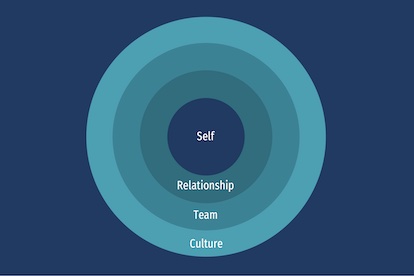In this article, learn effective strategies for managing employees with a high psychological safety need for esteem in the corporate world. Maximize their potential and boost team performance by understanding the psychological safety need for Esteem.
In the corporate world, I’ve always wondered why some people wear a suit and tie every day, while others dress in casual, sometimes worn-out clothes. These choices made me curious: were the suit-wearers trying to impress others or just enjoying dressing up? Were the casually dressed being frugal, or did they lack self-respect?
After tactfully asking some people about their choices, I found both groups had good reasons. Suit-wearers dressed up for themselves and others, while those dressing down had valid reasons, but none that pointed to low self-respect.
I realized these differences went deeper into how our brains work. People who always want to present themselves in the best possible light are similar to those who always need to be right, like to win, or present perfect images on social media. These behaviors stem from a need to feel elevated in the social hierarchy.
We call this “Esteem,” but it’s not the typical esteem we think about. The type of Esteem I am talking about is an emotional trigger, hence there is low sensitivity to it and high sensitivity to it.
Esteem in Action
When I understood this, everything made more sense. People who didn’t care about having the best clothes or who weren’t competitive didn’t lack self-respect. They simply had a low need for feeling high in the social hierarchy. They’d say things like, “I don’t need to dress well to know I’m good at my job,” or “I’d rather be comfortable than compete in a fashion show.”
Interestingly, those with a high need for Esteem often judged those with a lower need. They’d say, “Doesn’t Dave know people judge him by the way he dresses?” or “I’d be embarrassed to leave the house like that.” Their comments showed that they were triggered by social status.
The Six Domains of Psychological S.A.F.E.T.Y.™ and Triggers of Human Behavior
This led me to a broader truth: while we’re all different, we share common triggers that influence our behavior and psychological safety. Neuroscience identifies six main triggers, summarized by the acronym S.A.F.E.T.Y.™
- Security: The need for predictability, consistency, and certainty (Change is bad).
- Autonomy: The desire to have control over one’s environment.
- Fairness: The intrinsic need for equitable interactions.
- Esteem: The need for self-respect and acknowledgment.
- Trust: The social requirement to belong to and protect those we deem “like us”.
- You: Your unique experiences, influences and goals
Each of these triggers lives on a continuum, and every individual has a different sensitivity to each. That level of sensitivity changes how you respond to the world around you, how you interact with others, and what habits you build in your life.
Managing Esteem in Relationships
Firstly, there is no such thing as a person who has no need for Esteem. Just because a person has a low need for it, does not mean they do not need it. It only means that they are less sensitive compared to others.
So, this advice can work with pretty much every human being on the planet, but it will be more critical in certain relationships compared to others.
1. Realize that people with high need for Esteem will literally suffer if they are made to look bad in public. So, if you are going to give critical feedback, do it in private.
2. Compliments are appreciated, particularly about a thing they are proud of. That means, at work, the annual bonus is important, and so is the title increase. Both of these things recognize accomplishment and provide status.
3. Be careful about putting two people with high need for status in competition with each other, especially if they are supposed to be inside a team together. If you want them to compete, like if they are in a sales team, then this can be constructive for the company. But if they are on a product team or an HR team then this can be damaging. (Imagine a team where each member always needs to be right – disaster). It may be better to put a person with a higher need for Esteem together with a person with a lower need for Esteem in these other cases.
4. Help your team learn about their triggers. Learning and understanding makes people feel smarter and more self-aware, which increases their sense of status. Take the S.A.F.E.T.Y.™ Self-Assessment.
At the Academy of Brain-Based Leadership, we provide tools and workshops to help individuals and teams understand their triggers and manage their psychological safety for improved wellbeing and performance. Contact us to learn more about our workplace solutions.
We also offer a Psychological Safety Accreditation Program for Coaches, Consultants and Leaders, as well as an on demand Brain-based Leadership Certificate.
FAQs
How can I manage employees with a high need for Esteem?
Provide critical feedback in private, recognize their achievements, avoid unnecessary competition, and educate them about their psychological triggers.
Why do some employees not care about dressing up for work?
Some employees have a low psychological safety need for Esteem and do not feel the need to compete in social status through their appearance.
What are the six triggers of human behavior identified by neuroscience?
The six triggers are Security, Autonomy, Fairness, Esteem, Trust, and You (individual unique experiences).
What is the SAFETY Model?
Based on the latest neuroscience, the S.A.F.E.T.Y.™ Model describes six domains of threat or reward that are important to the brain. They are: Security, Autonomy, Fairness, Esteem, Trust and You.
Understanding the needs, rewards, motivations, biases, and stress triggers of each domain provides valuable insights, improving interactions, teamwork, and productivity while fostering a sense of safety and well-being in the workplace.
How can understanding Esteem improve team performance?
Understanding Esteem can help in managing team dynamics better, ensuring that individuals’ needs for recognition and respect are met, leading to increased motivation and performance.
What should I avoid when managing someone with high Esteem needs?
Avoid public criticism and unnecessary competition within the team, as these can negatively impact those with high Esteem needs.
Conclusion
In conclusion, managing someone with a high psychological safety need for Esteem involves understanding their triggers and ensuring their need for recognition and status is met. By providing feedback in private, recognizing achievements, and avoiding unnecessary competition, you can create a supportive environment that maximizes their potential and boosts overall team performance.



